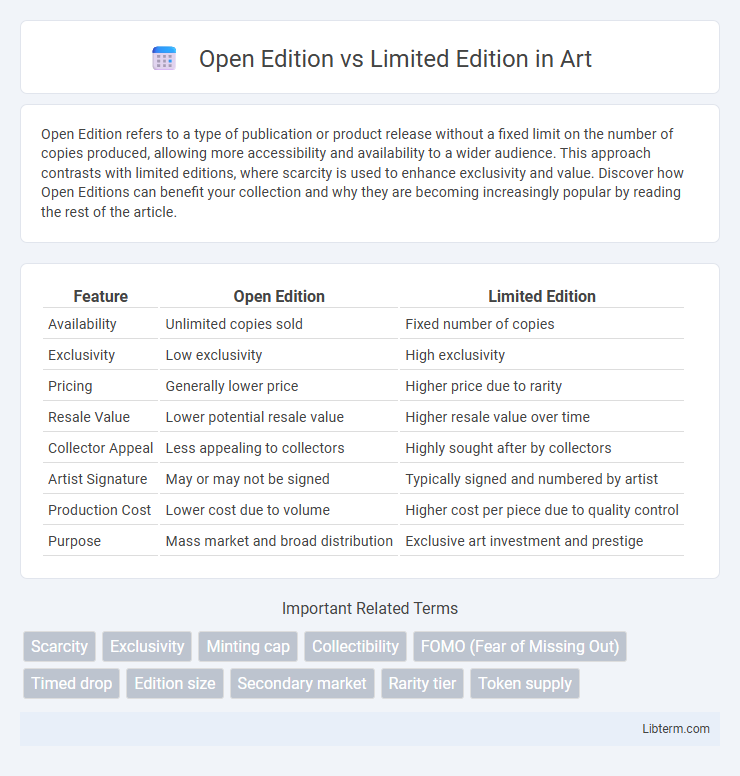Open Edition refers to a type of publication or product release without a fixed limit on the number of copies produced, allowing more accessibility and availability to a wider audience. This approach contrasts with limited editions, where scarcity is used to enhance exclusivity and value. Discover how Open Editions can benefit your collection and why they are becoming increasingly popular by reading the rest of the article.
Table of Comparison
| Feature | Open Edition | Limited Edition |
|---|---|---|
| Availability | Unlimited copies sold | Fixed number of copies |
| Exclusivity | Low exclusivity | High exclusivity |
| Pricing | Generally lower price | Higher price due to rarity |
| Resale Value | Lower potential resale value | Higher resale value over time |
| Collector Appeal | Less appealing to collectors | Highly sought after by collectors |
| Artist Signature | May or may not be signed | Typically signed and numbered by artist |
| Production Cost | Lower cost due to volume | Higher cost per piece due to quality control |
| Purpose | Mass market and broad distribution | Exclusive art investment and prestige |
Understanding Open Edition vs Limited Edition
Open Edition prints have no fixed quantity, allowing unlimited sales and continuous availability, which often results in more accessible pricing. Limited Edition prints are restricted to a specific number of copies, enhancing exclusivity and potential value due to their scarcity. Understanding these differences is crucial for collectors and buyers aiming to balance investment potential with acquisition accessibility.
Key Differences Between Open and Limited Editions
Open editions allow unlimited print runs, providing easier access and affordability compared to limited editions that are capped at a specific number, ensuring exclusivity and potential value appreciation. Limited editions often include numbered certificates to authenticate rarity, whereas open editions lack such restrictions or unique identifiers. Collectors typically prize limited editions for their scarcity, while open editions cater to a broader audience seeking more accessible art or merchandise.
The Appeal of Open Edition Artworks
Open Edition artworks attract collectors with their accessibility and affordability, allowing more fans to own pieces without the constraint of a fixed print run. The flexibility in availability encourages broader distribution and democratizes art ownership, making it appealing for emerging artists to grow their audience. Open Editions often foster a dynamic market where enthusiasts can invest in art without the premium cost associated with Limited Editions.
The Exclusivity Factor in Limited Editions
Limited Edition products are defined by their exclusivity, with a strictly controlled number of items produced, enhancing their rarity and perceived value among collectors and enthusiasts. This scarcity drives demand and allows sellers to command premium pricing compared to Open Editions, which have unlimited availability and no restriction on quantity. The exclusivity factor in Limited Editions often includes unique features, special packaging, or authentication certificates that further distinguish them from mass-produced Open Editions.
Pricing Strategies: Open vs Limited Editions
Open Edition prints typically feature flexible pricing strategies, often set at a lower price point to encourage higher volume sales and accessibility. Limited Edition prints are priced higher due to their scarcity, exclusive nature, and potential for increased value over time, appealing to collectors and investors. Pricing strategies for Limited Editions leverage rarity by controlling supply, while Open Editions rely on volume and affordability to maximize revenue.
Collectors’ Perspective: What Drives Demand?
Collectors prioritize rarity and exclusivity when deciding between Open Edition and Limited Edition items, valuing the potential for increased future value in Limited Editions due to fixed quantities. Open Editions attract collectors seeking accessibility and broader availability, often fostering community engagement and widespread ownership. Market trends show Limited Editions typically generate higher demand and investment appeal, while Open Editions provide entry points for new collectors.
Artists’ Benefits: Choosing Open or Limited Editions
Open editions provide artists with continuous revenue by allowing unlimited prints, attracting a broader audience and maximizing exposure. Limited editions create scarcity, increasing artwork value and exclusivity, which can enhance an artist's reputation and command higher prices. Both models offer distinct benefits, with open editions favoring volume sales and ongoing income, while limited editions focus on rarity and premium market positioning.
Investment Value: Which Edition Holds More Worth?
Limited Edition artworks typically hold more investment value due to their scarcity, often resulting in higher demand and increased price appreciation over time. Open Edition prints, produced without a fixed limit, tend to be less valuable as their abundance reduces exclusivity and potential for significant financial gain. Investors prioritize Limited Editions for their unique serial numbers and authenticated rarity, which enhances long-term worth in art markets.
Common Myths About Art Editions
Common myths about art editions include the belief that open editions are less valuable than limited editions, but value depends on artist reputation and demand rather than edition type. Some assume limited editions guarantee higher quality or exclusivity, yet open editions can feature the same artistic detail and popularity. Another misconception is that limited editions always appreciate in value, whereas market trends and provenance play critical roles in determining an artwork's financial worth.
Making the Right Choice: Open or Limited Edition?
Choosing between Open Edition and Limited Edition art depends on your goals and budget. Open Edition prints offer affordability and broad availability, ideal for casual collectors or those seeking more flexibility. Limited Edition prints provide exclusivity and potential investment value, often accompanied by certificates of authenticity and numbered runs to enhance rarity.
Open Edition Infographic

 libterm.com
libterm.com